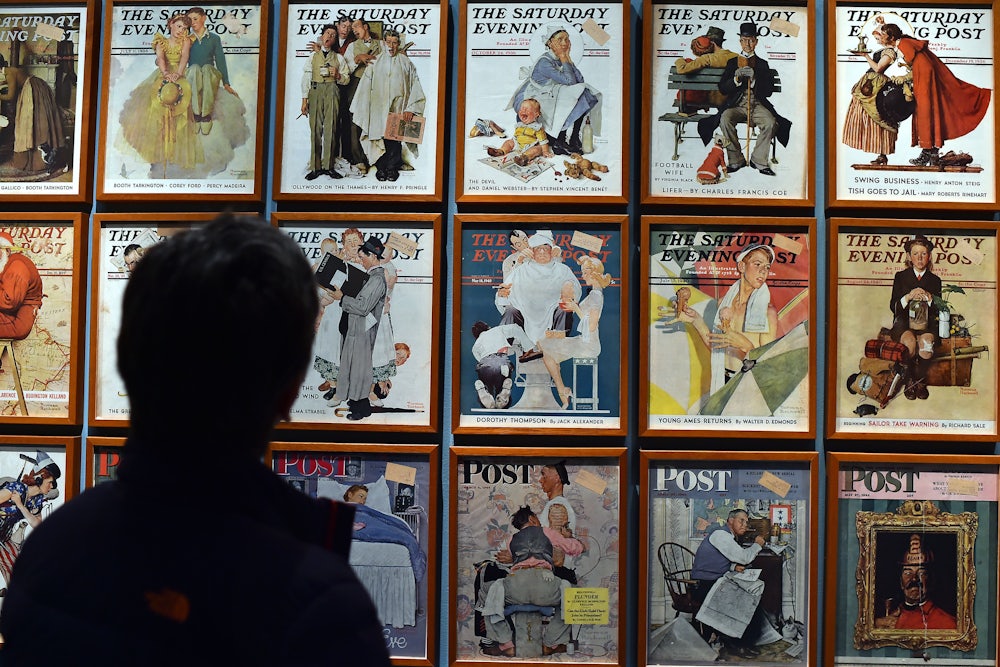Visitors didn’t seem to be enjoying themselves all that much when I was at the Norman Rockwell show at the High Museum a couple of weeks ago. I had the feeling that some museumgoers, after taking a close look at these finicky renderings of puppy love and civic pride, wondered why the show had set off a national media blizzard. During his lifetime Rockwell sold an idea—a bromide labeled “The Real America”—and now it’s the idea of Rockwell that holds the public. Standing in the first, dark-green gallery at the museum, visitors listened earnestly to an audio tour that began like a mini town meeting: a male voice announced that “if [Rockwell] smokes a pipe he’s got to be all right”; a female voice wondered why some critics regard Rockwell “with such disdain.” This American conversation was a marketing exec’s fabrication, and, as such, it was perfect for Rockwell, that marketer extraordinaire. The pipe-smoking workaholic who died in 1978 at the age of 84 purveyed an earlier generation’s version of the kind of equal-opportunity nostalgia that Martha Stewart retails today. Like Martha, Norman understands that the audience, far from regarding his hokum as the real anything, admires such work as the supremely slick fakery that it is. No wonder Steven Spielberg is a Rockwell collector.
Rockwell’s work, with its pop-up verisimilitude and perfect day-before-yesterday historical details, is fascinatingly manipulative. People have always responded, at least subliminally, to his knowingness—to the arched-eyebrow undercurrents of this carefully manufactured populist vision. Now cultural reporters can’t resist revving up the old high-versus-low debates, because, when the Rockwell show’s national tour concludes in February 2002, the artist’s flamboyantly meticulous views of small-town America will be ensconced in New York’s Guggenheim Museum, that former bastion of classic abstract art. Well, you can display Norman Rockwell in the Guggenheim, but his canvases still won’t have the weight or density or immediacy that makes painting magical. What’s missing from these plodding anecdotes is the sensuousness—the visual physicality—that holds a museumgoer. And without some of that rapture a painter is nowhere.
Rockwell is being promoted as a really big artist, as a really complicated guy. A documentary in the PBS American Masters series emphasizes the dark side of his private life; his second wife was in and out of mental institutions. His oil paintings, however, are the biggest skeletons in this story; during his lifetime, Rockwell basically kept them for himself, content to send his images into the world as photomechanical reproductions in mass-market magazines. Only after his death did his heirs open a museum in Stockbridge, Massachusetts; and only now is he being presented as an ambitious painter who in life “passed” as a conventional illustrator. The Atlanta show has a postmodern, topsy-turvy, what’s-real-what’s-not element. Rockwell photographed models, painted from the photographs, and sold reproduction rights to the paintings, which were then photographed for magazines. But now the Saturday Evening Post covers, which were the real thing, are the replicas, and the hand-painted originals, which were behind-the-scenes preparations, are the real McCoy.
I am astonished by the cynicism of Rockwell’s admirers. Or are the experts, who sound like yahoos, actually in earnest? On the American Masters show, Robert Hughes gives Rockwell fancy early colonial resonances, announcing that the prissy stuff vibrates with utopian Puritan dreams of “American virtue.” In the show’s catalog, Dave Hickey, a postmodern aesthete who has fans at every cutting-edge art school, subjects Rockwell’s 1957 soda-fountain valentine, “After the Prom,” to what he must imagine is classical formal analysis. Hickey concludes that this simpering cartoon, with its wanly scumbled brown-and-white surfaces, is “one of the most complex, achieved emblems of agape, tolerance, and youthful promise ever painted.” In the New Yorker, Peter Schjeldahl, another hipper-than-thou critic, explains that “Rockwell painted beautifully” and finds Rockwell’s canvases “surprisingly large, dense, and sumptuous.” And, as if that were not enough, there’s another contingent—led by Robert Coles—that points to Rockwell’s embrace of themes of racial integration in the 1960s and pats him on the back for coming out of the closet as a liberal. Since when does being a liberal make you a good artist?
Schjeldahl is one of a number of writers who link Rockwell to Andy Warhol; he seems to believe that both artists “raise common images to the pitch of religious icons.” I’d put it another way: Rockwell is the perfect product for the museum in the age of Warhol—which is also Martha Stewart’s time. The market-driven mentality of so many American museums dates back to the 1980s, when Warholism and Reaganomics were complementary art-world forces, with Ronald Reagan’s policies generating the money that gilded Warhol’s trivia. Rockwell’s magazine covers announce the dawning of the Campbell’s-soup-can America in which both Warhol and Reagan rose to fame. Rockwell’s new fans claim that his detractors are afraid of good old-fashioned American experiences. I think it’s the Rockwell cheerleaders who are ruining our fun. They valorize pop culture; they turn American variety into a debased high-art product. Schjeldahl is tickled that Rockwell is going to the Guggenheim. He is “happy to endorse the notion, which seems ever less absurd as time goes on.” I suppose it’s true that, after Thomas Krens, the Guggenheim’s director, has mounted “The Art of the Motorcycle” and announced a museum-wide Giorgio Armani show, a Rockwell extravaganza is just another clever muddle of Dadaism, populism, philistinism, and commercialism.
In the American Masters documentary, Russell Baker recalls that, as a boy in Depression-era New Jersey, he made money selling the Saturday Evening Post door-to-door. It was a tough pitch. He describes out-of-work men who looked at the magazine for which Rockwell ultimately did 322 covers and asked the young Baker if he didn’t have something else—maybe True Story or True Detective. “They wanted to read about vice and adultery,” Baker explains. At the High Museum it wasn’t vice and adultery that I found in short supply; it was art. This show is subtitled “Pictures for the American People.” The people deserve better.
